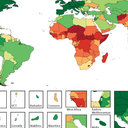Predictors of outcome in fulminant hepatic failure in children.
کلید واژه ها
خلاصه
OBJECTIVE
To identify the predictors of outcome in fulminant hepatic failure (FHF) in children.
METHODS
Prospective cohort study.
METHODS
41 children with FHF were studied. Patient characteristics and findings on examination at the time of hospitalization were noted. Serum biochemistry and screening for hepatotropic viruses (A, B and C) were done in each patient. Patients were treated using a predefined protocol and followed up till death or discharge. Univariate and multivariate analysis was done to find the predictors of outcome.
RESULTS
Hepatitis B was the commonest cause of FHF (11 children; 26.9%). Markers for hepatitis A and C viruses were present in one and two patients, respectively. Serology was negative in 27 children (65.9%), of whom two had history of ingestion of hepatotoxins (antitubercular drugs). The overall mortality was 61%. Irrespective of etiology, the following factors were associated with poor outcome on univariate analysis: presence of gastrointestinal (GI) hemorrhage, serum bilirubin more than 10 mg/dL, age 6 years or less, coma of grade 3 or more, presence of infection, prolongation of prothrombin time > 8 s over control, prothrombin concentration < 50%, hypoglycemia (blood glucose < 45 mg/dL), hyponatremia (serum sodium < 125 mEq/L) and hyperkalemia (serum potassium > 5.5 mEq/L). On multiple logistic regression analysis, presence of GI hemorrhage (p = 0.005), degree of coma (p = 0.02) and serum bilirubin level (p = 0.025) were identified as independent predictors of mortality.




